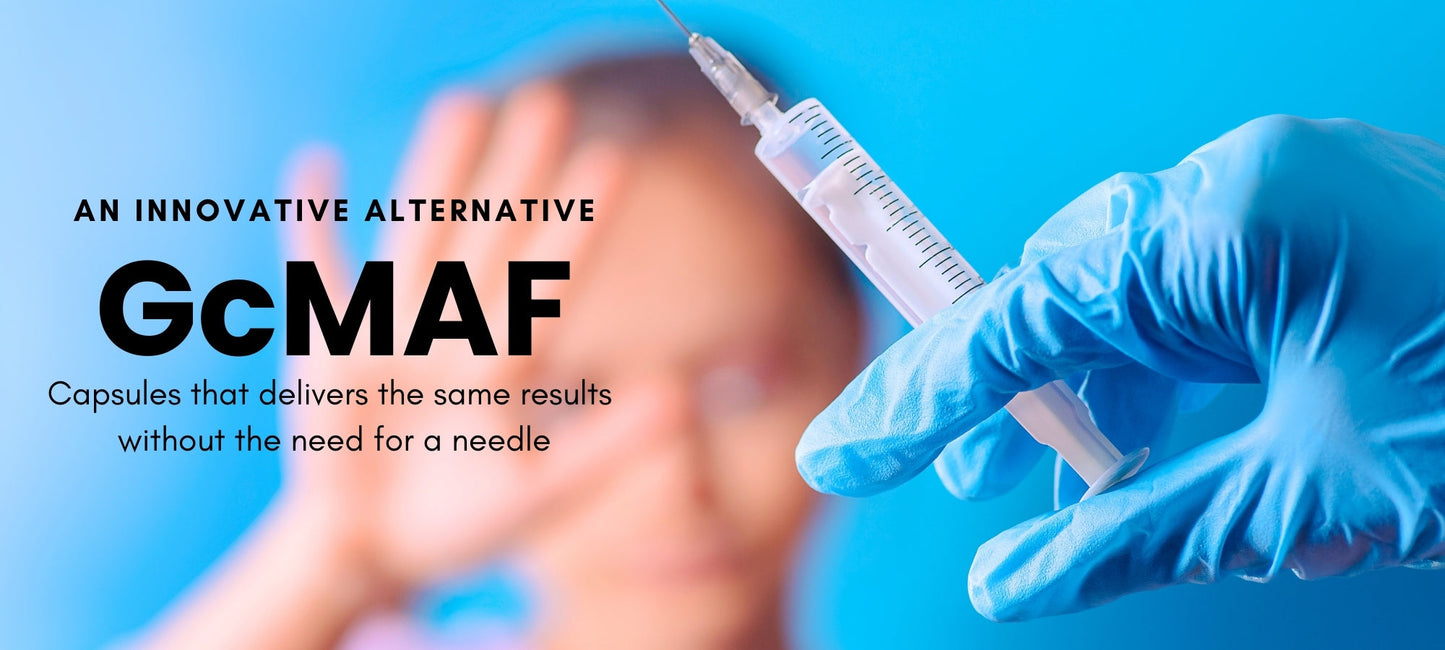
What is GcMAF? GcMAF is a macrophage-activating factor synthesized from the Gc-protein (i.e., Gc-globulin, a vitamin D-binding protein). At MAF Supplies, we make GcMAF from bovine colostrum.
GcMAF works exactly like the body’s naturally occurring macrophage-activating factors. GcMAF mimics MAF even in the way the latter plays a crucial role in regulating pain and inflammation—which is why GcMAF is one of the best supplements for pain and inflammation.
To understand how GcMAF works as an ingredient in back pain supplements, muscle pain supplements, joint pain supplements, and other types of pain relief supplements, first, you must understand how MAF (as well as GcMAF) works.
How MAF (and GcMAF) Works
MAF (and, thus, GcMAF) activates macrophages. That’s it. That is its sole function, but no one can disregard the significance of its macrophage-activation role.
Macrophages are a type of white blood cell essential to the body’s immunity. Their immune system response functions include microbicidal action, phagocytosis, and apoptosis.
Antimicrobial Function
Macrophages secrete nitric oxide, which is highly potent against microbes or pathogens, including bacteria, viruses, and fungi. Macrophages also play an essential role in triggering or activating the body’s immune cells and immune system response.
After killing pathogens, they attach a fragment of the infectious microbes on their surface (i.e., antigen presentation) and present them to T cells while simultaneously providing costimulatory signalling and secreting cytokines that draw other immune cells to the infection site.
Phagocytosis
Macrophages are phagocytes. They engulf, ingest, and digest foreign substances. What are the benefits of phagocytosis?
- Autophagy: By ingesting dead and damaged cells and cell debris, macrophages enable autophagy or the breakdown and recycling of old cell parts.
- Homeostasis: By keeping the body clear of cellular debris, foreign substances, heavy metals, and other toxins, macrophages help maintain homeostasis or a stable cell environment, which promotes optimal cell function and helps prevent cellular debris build-up that can trigger inflammation. In particular, the way macrophages help remove the DNA released during cell death is essential to preventing autoimmunity.
- Tissue repair and healing: By clearing cellular debris, macrophages help trigger the body’s tissue repair and healing mechanisms.
Apoptosis
Macrophages can express proteins that activate mechanisms that subsequently lead to cell death in infected and damaged cells. This helps the immune system prevent the spread of infection and instigates cell regeneration.
Phagocytosis complements apoptosis. Macrophages promptly engulf apoptotic cells to prevent the release of cellular debris that can lead to inflammatory responses.
Macrophages and Inflammation (and Pain) Regulation
Through their antimicrobial, apoptotic and phagocytic functions, macrophages fight against infections and keep the body clear of cellular debris, in the process regulating inflammation and pain.
When actively fighting infections (i.e., secreting nitric oxide and attracting other immune cells), they are pro-inflammatory. However, when engulfing foreign substances, damaged cells, and pathogenic remnants, they are anti-inflammatory.
In other words, macrophages can be polarized to express two primary phenotypes: M1 and M2.
- M1 macrophages: M1 macrophages are pro-inflammatory. They lead to inflammation and are thus highly anti-pathogenic. They also secrete cytokines to attract other immune cells to the infection site. While this enhances their anti-pathogenic effectiveness, it also increases pain sensitivity.
- M2 macrophages: M2 macrophages are anti-inflammatory macrophages. They secrete cytokines that signal phagocytosis or the engulfing of damaged and dead cells. M2 macrophages suppress inflammation and promote healing and tissue repair.
Why GcMAF Natural Pain Relief Supplements Work
Macrophage-activating factors, including GcMAF supplements, work against pain and inflammation because they can induce the expression of M2 macrophages or macrophages with a highly potent phagocytic action that cleans cells, clear out cellular debris, suppress inflammation, and promote tissue repair and healing.
One of the primary GcMAF benefits is how it supports the body’s normal immune function. GcMAF can activate macrophages to fight infections when there are pathogens in the body, in which case inflammation and pain naturally set in. However, after the infection or injury, the inflammation and pain ease up.
What reduces inflammation and pain? It’s the macrophages’ phagocytic activity. Specifically, M2 macrophages ingest the dead and damaged cells and cellular debris. This leads to healing, regeneration, the suppression of inflammation, decreased pain sensitivity, and the prevention of chronic pain and inflammation.
GcMAF can, thus, be one of the best anti-inflammatory supplements for back pain, muscle pain, and joint pain.
If you experience chronic pain or have an inflammatory disorder like rheumatoid arthritis, GcMAF can support your treatment because it can activate M2 macrophages that suppress inflammation and lessen pain sensitivity.
In the future, GcMAF action may even be more polarizing. Research shows a selective macrophage response to GcMAF activation may be possible. Supplements containing GcMAF, which activates only M2 (anti-inflammatory) macrophages, will surely become the best supplements for pain and inflammation.
MAF Supplies is a leading manufacturer and global distributor of high-quality, doctor-approved GcMAF supplements. You can use our GcMAF supplement for muscle pain, back pain, and joint pain. Shop GcMAF supplements now.
Author

Dr Toshio Inui
Doctor, expert in internal medicine and worldwide authority on GcMAF treatments, Dr. Inui is the visiting professor at Kagoshima University. He has dedicated his career to developing innovative treatments using MAF, and has 22 research works and 266 citations into macrophage activating factors.
